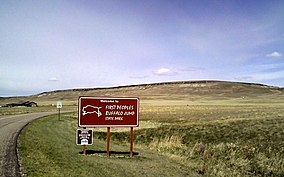| First Peoples Buffalo Jump State Park | |
|---|---|
 | |
| Location | Cascade County, Montana, United States |
| Nearest city | Great Falls, Montana |
| Coordinates | 47°29′23″N 111°31′45″W / 47.48972°N 111.52917°W[1] |
| Area | 1,481 acres (5.99 km2) |
| Elevation | 3,773 ft (1,150 m)[1] |
| Designation | Montana state park |
| Established | 1972[2] |
| Named for | A buffalo jump and the First Peoples of Montana |
| Visitors | 20,280 (in 2016)[3] |
| Administrator | Montana Fish, Wildlife & Parks |
| Website | First Peoples Buffalo Jump State Park |
First Peoples Buffalo Jump State Park is a Montana state park and National Historic Landmark in Cascade County, Montana in the United States. The park is 1,481 acres (599 ha) and sits at an elevation of 3,773 feet (1,150 m).[1] It is located about 3.5 miles (5.6 km) northwest of the small town of Ulm, which is near the city of Great Falls. First Peoples Buffalo Jump State Park contains the Ulm Pishkun (also known as the Ulm Buffalo Jump), a historic buffalo jump utilized by the Native American tribes of North America.[2] It has been described as, geographically speaking, either North America's largest buffalo jump[4][5][6] or the world's largest.[7][8] There is some evidence that it was the most utilized buffalo jump in the world.[9] The site was added to the National Register of Historic Places on December 17, 1974,[10] and designated a National Historic Landmark in August 2015.[11] The former name of the park was derived from the Blackfeet word "Pis'kun," meaning "deep kettle of blood," and the nearby town of Ulm.[12][13][14]
Although there are more than 300 buffalo kill sites in Montana,[15] First People's Buffalo Jump is one of only three protected buffalo jumps in the state. The other two are Madison Buffalo Jump near Three Forks, and Wahkpa Chu'gn near Havre,[16] both of which are also on the National Register of Historic Places.[10] It may be the largest bison cliff jump in North America.[11]
- ^ a b c "First Peoples Buffalo Jump State Park". Geographic Names Information System. United States Geological Survey. January 1, 1995. Retrieved October 26, 2011.
- ^ a b "Ulm Pishkun State Park Management Plan: Final". Montana Fish, Wildlife & Parks. December 2005. p. iv. Retrieved June 30, 2020.
- ^ "2016 Annual Visitation Report". Montana State Parks. Archived from the original on January 12, 2017. Retrieved June 30, 2018.
- ^ Alberta-Montana Heritage Partnership, p. 272; Gale, p. 143; Gottberg, Harris, and Haselsteiner, p. 579.
- ^ Robison, p. 13.
- ^ Baumler, p. 15.
- ^ Wilson, p. 256; Wright, p. 7; Conklin, p. 40; Gilles, p. 52.
- ^ Schalla and Johnson, p. 60.
- ^ Puckett, Karl. "Historic Buffalo Jump Site." Great Falls Tribune. May 30, 1999.
- ^ a b Puckett, Karl. "Bison Kill Site Yields Terrific Old Treasures." Great Falls Tribune. July 5, 1999.
- ^ a b Sherman, David. "First Peoples Buffalo Jump designated as National Historic Landmark". KTVQ. Retrieved October 30, 2017.
- ^ Aarstad et al., p. 272.
- ^ "Ulm Pishkun State Park Management Plan: Final". Montana Fish, Wildlife & Parks. December 2005. p. 1. Retrieved June 30, 2020.
- ^ In March 1999, the Blackfeet tribe of Montana asked that the public and state officials begin calling the site by a new name, Kakpayta Peyasu Pishkun (or Listening Thunder Pishkun). However, state officials said that since the site was used by many tribes and not just the Blackfeet, the old name would stay. See: Puckett, Karl. "Group Says It Changed the Name of Ulm Pishkun." Great Falls Tribune. March 8, 1999.
- ^ Cite error: The named reference
Punkewas invoked but never defined (see the help page). - ^ Graf, p. 20
© MMXXIII Rich X Search. We shall prevail. All rights reserved. Rich X Search

